Elizabeth Anderson
May 13, 2015
Suitcase for Germany
Bags:
1 backpack (carry-on)
1 purse
1 large checked suitcase
1 rucksack
1 light travel bag for computer/souvenirs
Documents:
• Passport
• Work Visa
• Prescription papers
• Immune records
• Credit card
• Debit card
• Extra cash
• (an extra copy of all personal info will be left with my mother)
Electronics:
• Mac laptop
• Mac charger
• Portable GPS for navigation
• Power Converter
• Electrical adaptor
• Canon camera and equipment
• Extra camera batteries
• Battery charger
• Laptop and laptop cord
• IPhone and charger
• Recorder
• Batteries for recorder
• Head phones
• Wrist watch
Non-electronic equipment:
• 10 white reporter flip notebooks
• 10 pens
• Address book with professional and personal contacts
• Pocket knife (checked bag)
• Pepper spray (checked bag)
• Quart size zip-lock bags (carry-on)
Foul weather gear:
• Compactable umbrella
• Compactable rain-poncho
• Raincoat
• Formal pea coat
• Casual black jacket
• Fleece jacket
• Sweatshirt
• Hat
Clothing:
• 2 dresses
• 5 blouses
• 5 t-shirts
• 2 pair jeans
• 2 pair shorts
• 2 pair dress pants (1 black 1 gray)
• 5 long sleeve shirts
• 2 strap tank tops
• Sleep wear
• Belts
• Undergarments
• Socks
Shoes:
• Rain boots
• Black flats
• Beige flats
• Tennis shoes
• 1 pair dress
• 2 pair boots
Toiletries:
• Toothpaste
• Tooth brush
• 3 wash cloths
• Hair brush
• Hair ties
• Bobby pins
• Makeup
• Makeup remover
• Lotion
• Q-tips
First-aid essentials:
• Bandages
• Antibacterial ointment
• Duct tape
• Tweezers
• Needle/thread, kit
• Safety pins
• Compression bandage
• Nail clippers and file
• Bug repellant
• Sunscreen
• Small travel mirror
• Feminine hygiene products
Supplements:
• Medications
• Multi-vitamins
• Vitamin B, D, C
• Antibiotics
• Water purification tablets
• Probiotics
Miscellaneous:
• Money belt
• Extra cash to buy things at drug store
• Sunglasses
• Water bottle
• Sleeping bag liner
• Pillow liner
• Tissues
• Hand sanitizer
http://www.virtualtourist.com/travel/Europe/Germany/Packing_Lists-Germany-TG-C-1.html


